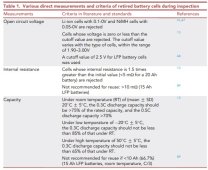svetz
Works in theory! Practice? That's something else
I've been reading that some LFP cells have organic electrolytes that break down over time, and some use special coatings on the anode that swell over time, and that they'll only last a decade. It was even recently posted that they're unsafe once they fall below 80% capacity.
But, I've also seen papers regarding repurposing packs from cars after their end of life in that venue as home and grid storage. In fact, I believe @GXMnow is one of the folks that's done this with a chevy bolt pack and keeps an eye on the "fire" news related to it.
So, figured the folks in this forum know what's really what. Here's some questions, but I don't know enough to know if I'm asking the right things...
If your cells are older than a decade, what percent capacity are they are and how far will you run them before retiring them? Or are there specific things you annually inspect each cell for to decide to replace it (e.g., internal resistance, rust, swelling)?
But, I've also seen papers regarding repurposing packs from cars after their end of life in that venue as home and grid storage. In fact, I believe @GXMnow is one of the folks that's done this with a chevy bolt pack and keeps an eye on the "fire" news related to it.
So, figured the folks in this forum know what's really what. Here's some questions, but I don't know enough to know if I'm asking the right things...
- Is it that quality cells will work and "cheap" cells are dangerous?
- Is it confusion between lithium-ion and Lithium iron phosphate chemistries?
If your cells are older than a decade, what percent capacity are they are and how far will you run them before retiring them? Or are there specific things you annually inspect each cell for to decide to replace it (e.g., internal resistance, rust, swelling)?



